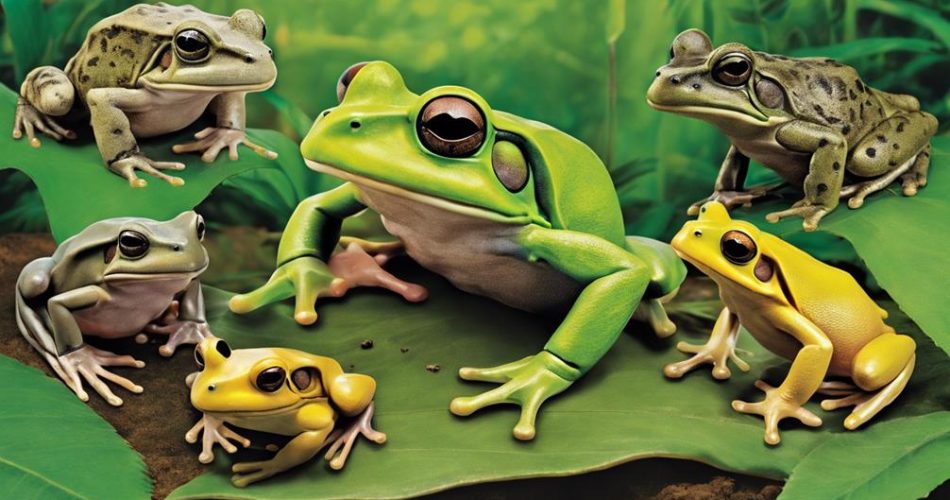Imagine a frog so huge, you'd think it leapt right out of a fairy tale. That's the Goliath frog, the largest living frog on Earth. You're about to embark on a remarkable journey through its life cycle, from egg and tadpole to the fully grown amphibian. It's a fascinating tale of growth, survival, and transformation.
But just as you're ready to leap into this intriguing world, hold on, there's more to this story. The Goliath frog's existence is under threat. Curious to know why? Let's explore together.
Key Takeaways
- Goliath frog eggs hatch into tadpoles that feed on algae, detritus, and invertebrates before developing into juveniles.
- Juvenile frogs display opportunistic feeding behavior, use their enlarged hind legs for foraging and evasion, and begin exploring land.
- Adult Goliath frogs, up to 32 cm long and 3.3 kg weight, primarily eat crustaceans and fish, and typically live for 15 years.
- The Goliath frog's survival is threatened by poaching and habitat destruction, necessitating community involvement and funding for in-situ conservation.
Origins of the Goliath Frog
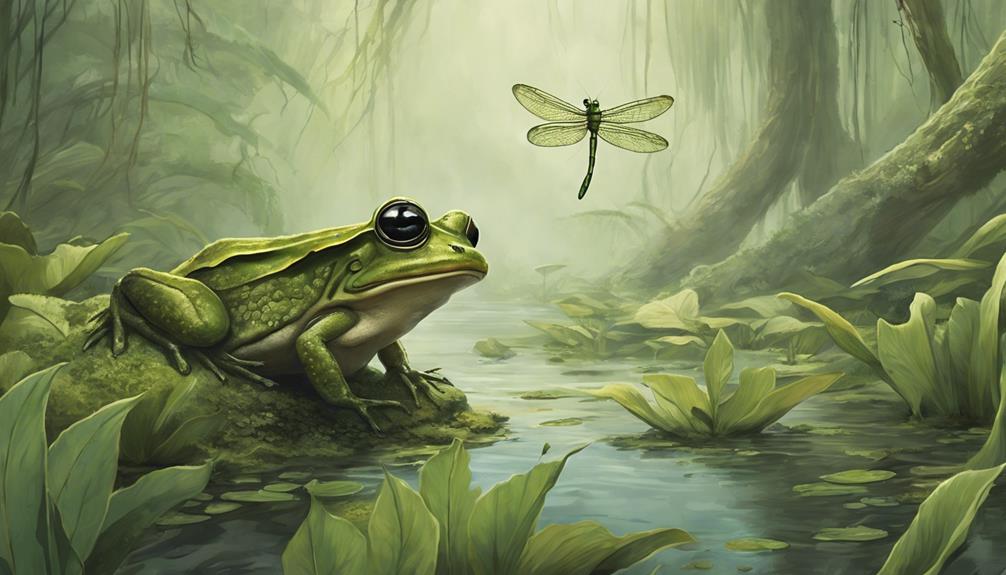
Diving into the origins of the Goliath frog, it's important to note that this colossal amphibian, scientifically known as Conraua goliath, hails from the fast-flowing rivers in the rainforests of Cameroon and Equatorial Guinea. This specific habitat is crucial to understanding the frog evolution and habitat adaptation of this gargantuan species.
In the realm of frog evolution, the Goliath frog stands as a fascinating anomaly. Unlike its smaller cousins, it's maintained a relatively stable form for several million years, suggesting a successful long-term adaptation to its environment. Your understanding of this amphibian's evolution isn't complete without considering its unique habitat adaptation.
The Goliath frog's preference for fast-flowing rivers provides it with a rich diet of crustaceans and fish, contributing to its massive size. These rivers, with their strong currents and rocky bottoms, offer an ideal environment for the world's largest frog. The high oxygen levels and cooler temperatures in these waters are beneficial for the Goliath frog's metabolism and overall health.
It's undeniable that the Goliath frog's evolution and habitat adaptation have greatly influenced its size and lifestyle. This magnificent creature's existence is a testament to the power of adaptation and the enduring mysteries of evolution.
The Egg and Tadpole Phase
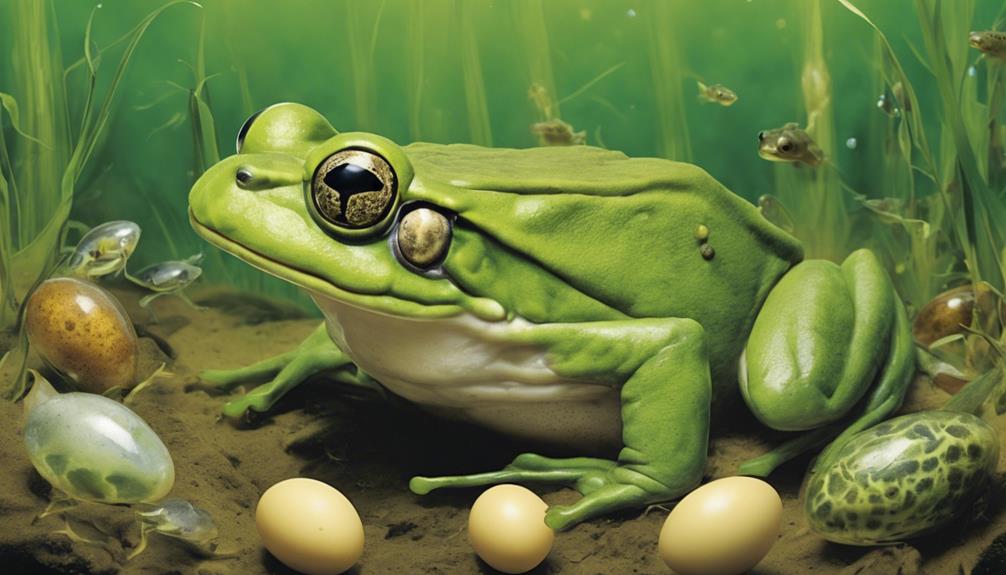
Understanding the Goliath frog's impressive size and adaptation to its unique habitat sets the stage for exploring its intriguing life cycle, starting with the egg and tadpole phase. This phase is marked by a multitude of predator threats, particularly from birds, snakes, and large insects. Even the eggs, laid in clusters on riverbed rocks, aren't safe from these dangers.
To combat these threats, Goliath frogs have evolved a fascinating adaptation. The eggs are coated in a layer of protective jelly-like substance, reducing the risk of predation. However, surviving predation isn't the only challenge these eggs face. They must also meet their nutritional requirements, which are predominantly fulfilled by the rich yolk within the eggs.
Once the eggs hatch into tadpoles, the nutritional requirements shift. Now, they feed on algae, detritus, and small invertebrates. It's a perilous world for these tadpoles, but those that can successfully navigate the predator threats and meet their nutritional needs have a chance of making it to the next phase of their life cycle.
In this phase, the tadpoles exhibit remarkable growth, fueled by their high-protein diet, setting the stage for their transition to the juvenile stage.
Transition to Juvenile Stage
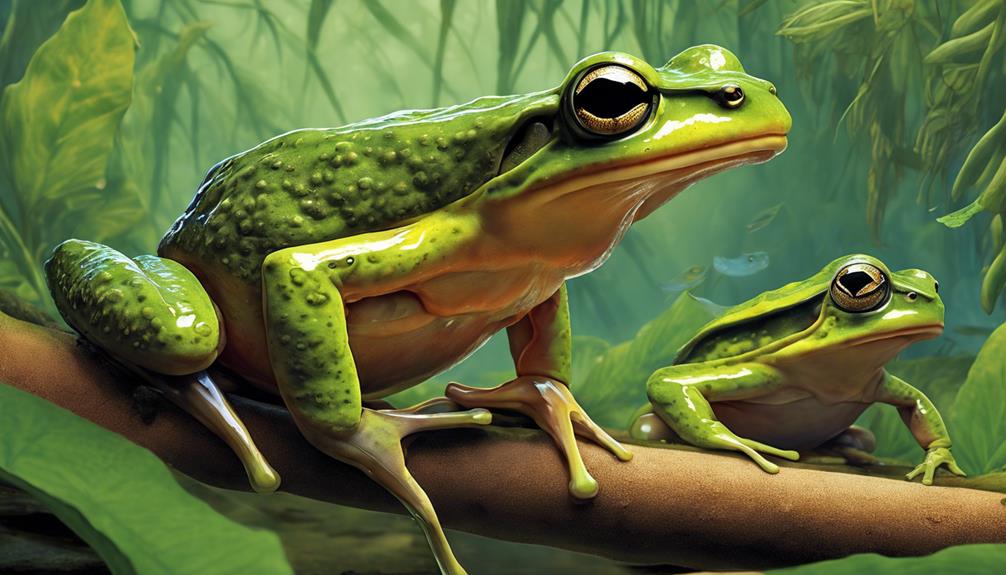
As the tadpoles grow and adapt to their aquatic environment, they reach a critical stage in their development where they transition into juveniles, marked by significant physical and behavioral changes. This metamorphosis includes developing limbs, losing gills, and forming lungs for terrestrial breathing.
During this stage, the juvenile diet undergoes a significant shift. While tadpoles primarily consume plant matter and detritus, juveniles show an opportunistic feeding behavior, consuming small invertebrates and aquatic insects. This dietary shift is crucial for their rapid growth and energy requirements.
Simultaneously, there's a marked change in habitat adaptation. No longer confined to the water, juveniles can now explore land. However, they still stay close to water sources, as their skin requires constant moisture. Their enlarged hind legs allow them to leap greater distances, aiding in both foraging and evasion of predators.
The transition to the juvenile stage is a testament to the Goliath frog's adaptability and resilience, a crucial phase that prepares them for the challenges of adulthood. This stage is marked not just by physical transformation, but also by a strategic shift in dietary intake and habitat selection, setting the stage for their eventual metamorphosis into the world's largest frog.
Adult Goliath Frog Characteristics
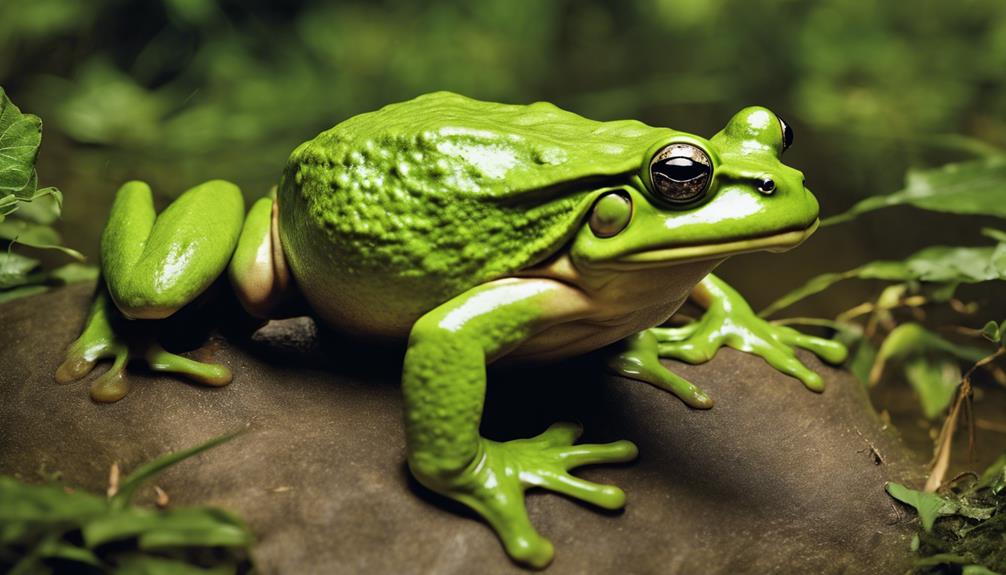
Now that they've undergone a significant metamorphosis, adult Goliath frogs embody a distinct set of characteristics that set them apart in the amphibian world.
Let's delve into their size comparison, one of their most striking features. Adult Goliath frogs can grow up to 32 cm in length, excluding the legs, and weigh up to 3.3 kg, making them the world's largest living frogs. To put it in perspective, that's roughly the size of a domestic cat!
Their physical size is closely linked to their diet. Unlike their juvenile counterparts who feed on small insects, adult Goliath frogs have a carnivorous diet. They primarily feed on crustaceans, fish, and small amphibians, which provide the necessary nutrients for maintaining their massive size.
| Characteristic | Detail |
|---|---|
| Size Comparison | Up to 32 cm in length, excluding the legs, and weighs up to 3.3 kg |
| Diet | Primarily carnivorous, feeding on crustaceans, fish, small amphibians |
| Lifespan | Typically 15 years in the wild |
| Habitat | Fast flowing rivers with sandy bottoms in Western Africa |
These characteristics make Goliath frogs fascinating, offering unique insights into their survival strategies in diverse ecosystems.
Threats and Conservation Efforts
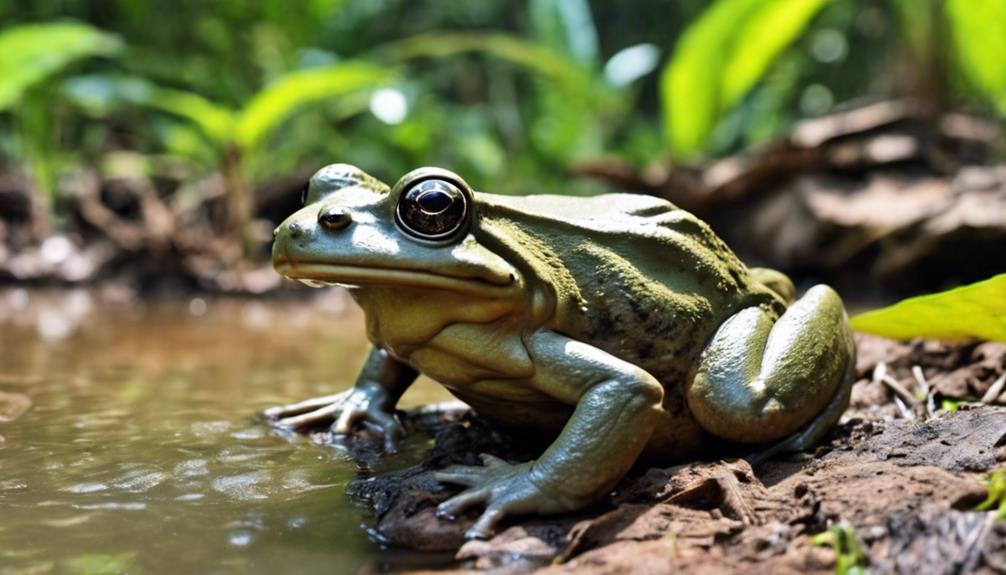
Despite their impressive size and strength, Goliath frogs face numerous threats that have led to dwindling populations and the need for urgent conservation efforts. The poaching impact on these colossal amphibians is significant, primarily driven by the exotic pet trade and their consumption as a delicacy. You'll find that poachers specifically target the largest specimens, leading to a decrease in genetic diversity and disruption of the population structure.
Habitat destruction poses another major threat. As rainforests are cleared for agriculture or urban development, the frogs' breeding sites – typically fast-flowing rivers with unique characteristics – are being lost. The removal of large river stones, which the females use for nesting, further contributes to their plight.
Conservation efforts are underway, but they're facing challenges. Captive breeding programs have been largely unsuccessful due to the frogs' complex reproductive requirements. In-situ conservation, like habitat protection and anti-poaching measures, shows more promise. However, it requires local community involvement and significant funding.
Frequently Asked Questions
What Is the Average Lifespan of a Goliath Frog in the Wild?
You're curious about the average lifespan of a goliath frog in the wild, aren't you?
It's fascinating because despite their size and unique adaptations, they're not immune to predation. Typically, they can live up to 15 years. However, threats like predation can shorten this.
Goliath frogs have developed incredible jumping and swimming abilities to escape predators, but it's a tough world out there for them.
What Are the Primary Food Sources for the Goliath Frog?
Inquiring about a Goliath frog's primary food sources, are you?
Well, they're quite the carnivores. They'll eat anything they can overpower, from insects and crustaceans to smaller amphibians and even other frogs.
Despite their size, they're not exempt from being prey themselves. Frog predators, like snakes and large birds, pose a significant threat.
This dynamic plays a critical role in amphibian conservation efforts, as sustaining a balanced ecosystem is key.
Are There Any Unique Behaviors or Traits Goliath Frogs Exhibit During Mating Season?
Yes, during mating season, Goliath frogs exhibit unique behaviors. They use specialized mating calls, an intriguing subject for analysis. You'd notice a deep, resonant croak echoing throughout their habitat. This is their way of attracting females.
In addition, these frogs show fascinating reproductive adaptations. They construct underwater nests for their eggs, ensuring a safer environment for their offspring. It's a testament to their adaptability and survival instincts.
How Do Goliath Frogs Interact With Other Species in Their Ecosystem?
You'll find Goliath frogs sharing their ecosystem with various species. They're a crucial part of the food chain, serving as both predator and prey.
These frogs help control insect populations, but they're also predatory threats to smaller creatures. They're prey for larger animals, contributing to the balance of their ecosystem.
However, human interference disrupts this balance, making it crucial to understand and respect their role in biodiversity.
What Environmental Conditions Are Most Favorable for the Goliath Frog's Habitat?
You'd prefer an environment rich in water bodies, like rivers and streams, if you were a Goliath frog. They love warm climates too, typically in places like West Africa.
But, there's trouble in paradise. Their habitat faces threats from human activities, like deforestation and pollution. Conservation efforts are crucial to protect these amphibians and their preferred habitats.
Conclusion
In conclusion, you've journeyed through the life cycle of the goliath frog, from its origins to its transformation into the world's largest frog.
You've seen the threats they face, emphasizing the urgent need for conservation efforts. Remember, understanding and respecting these creatures' life cycle is vital.
It's not just about preserving a species; it's about maintaining the delicate balance of our ecosystem.


